
Crabby
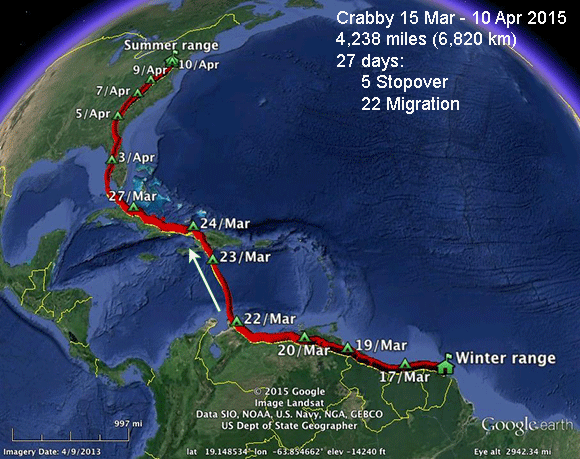 |
Spring migration 2015Crabby took off on the 15th of March on a tour of South American capitals. She flew just south of Cayenne, through the outskirts of Paramaibo, and made it past Georgetown without imbibing in the local cool aid! She has roughly 2,300 miles (3,700 km) to go. I expect her back on the Chesapeake sometime in the second week of April. Right now (24 March) she's probably somewhere between S.A. and eastern Cuba. Scroll down for more detailed maps and a brief bio. |
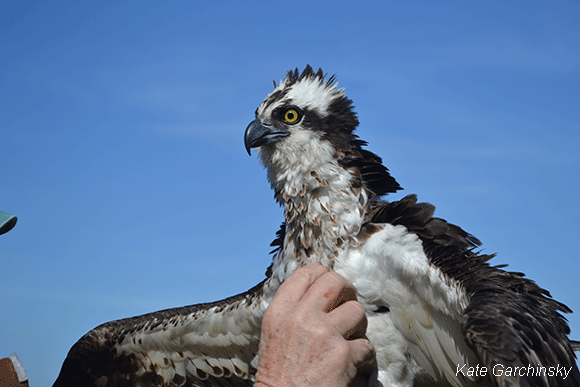 |
BioCrabby was named in part for the location (Crab Alley Bay) where we trapped her, but also for her very feisty nature. She was trapped, on April 21st, at a nest on Kent Island in the upper Chesapeake Bay as part of my collaboration with Microwave Telemetry, Inc., manufacturers of all my transmitters, and the Chesapeake Bay Foundation. Together, we have tagged six Ospreys (four last year and two this spring) on Chesapeake Bay. We were trying to catch the adult male at a nest on Cox Neck. When we arrived we discovered a bit of drama at the nest. The female was sitting on eggs with her mate in attendance, but there was an extra bird present. We caught the resident female in about 4 minutes and then held her while we waited for the male to get caught. The male was close by and would appear when the invading bird came near the nest, but he did not land on the nest trap. After a rather long time with no action, I declared that it didn't look good for catching a bird at this nest. Less than a minute later (really) a bird just dropped down on the nest and was caught. This turned out to be a young female looking for love in all the wrong places. It often takes a few years for young birds to work their way into the breeding population. We were short on time and had a transmitter in hand, so we decided to change our plan and tag the "extra" female. It turned out to be an interesting choice. |
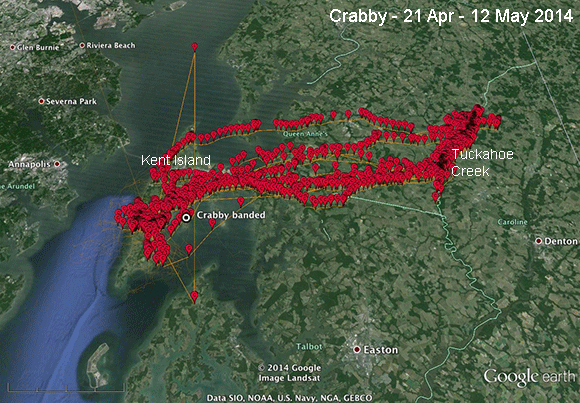 |
21 Apr-12 MayCrabby did not return to the nest where we trapped her. She continued to explore Kent Island, but also made five trips over to Tuckahoe Creek, about 24 miles (38 km) east of Cox Neck. During the three week period, she made 5 trips to Tuckahoe Creek. Jim Uphoff, a fisheries biologist with Maryland's Dept. of Natural Resources, reports that Alewife, Blueback Herring, Hickory Shad, Gizzard Shad, as well as Yellow and White Perch run up Tuckahoe Creek. All of those are favorite Osprey chow.
(The point north of Kent Island in the middle of the Bay is just a bad GPS location.) |
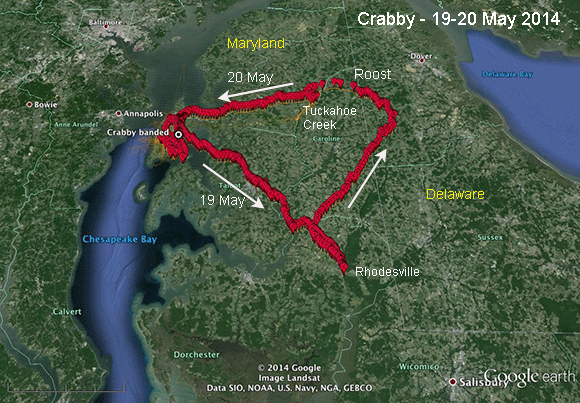 |
19-20 MayCrabby went on a two-day road trip. She left Kent Island around noon on the 19th, flew southeast for about 35 miles to Rhodesdale, MD, just west of Marshhope Creek, and then, abruptly backtracked and headed northeast. Her trip down to Rhodesville was strange. She was never over any water that looked "fishable" She flew another 40 miles or so, spent some time fishing at a little pond exactly on the Maryland-Delaware border. On the 20th, she spent 3 hours fishing along Tuckahoe Creek and then headed back to Kent Island, arriving there around 2PM. |
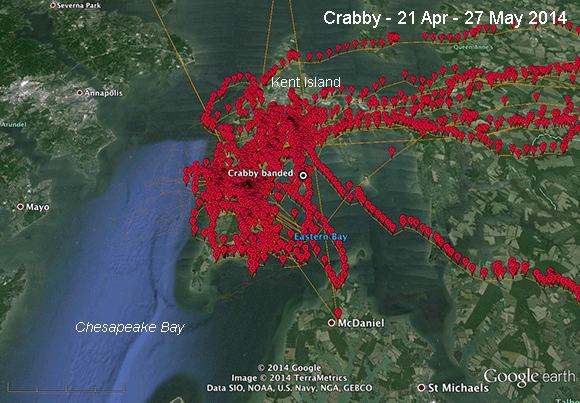 |
21 Apr - 27 MayFor the first five weeks we followed her, most of Crabby's movements were east of Kent Island, including her runs over to Tuckahoe Creek. |
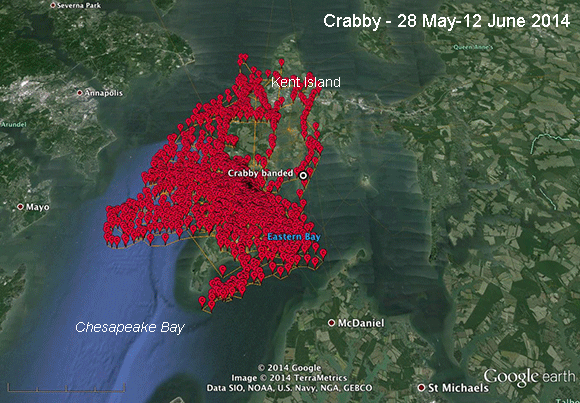 |
28 May-12 JuneIn the past three weeks, Crabby has been concentrating her fishing efforts west of Kent Island in Chesapeake Bay. This begs the question, did some fish just move up the Bay and become available, or did she just start fishing over there by chance. I'll have to check in with our fisheries biologists to get their take on the situation. |
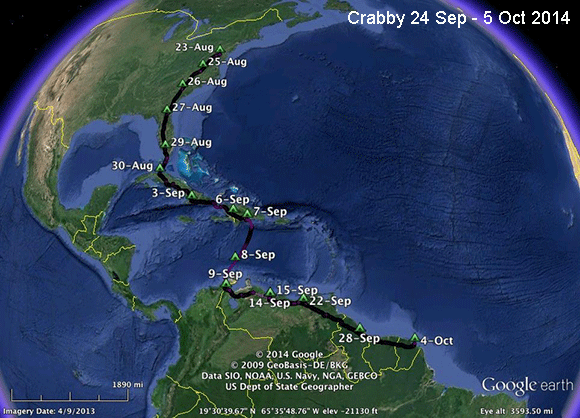 |
Fall migration 2014Crabby had an uneventful migration in the fall of 2014. After arriving in South America on the 9th of September, she passed through Colombia, Venezuela, Guyana, and Suriname before arriving at her final destination in French Guiana.
|
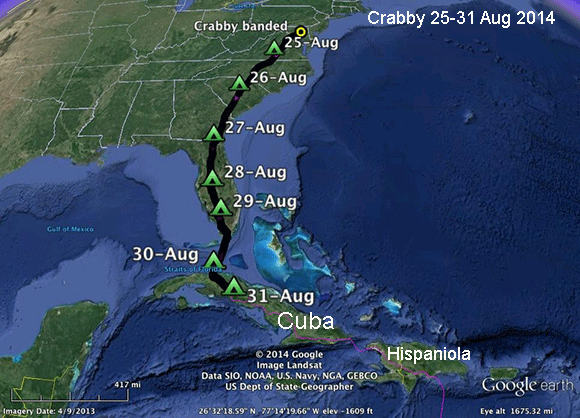 |
Migration begins - 25 AugustThe rest of the summer was uneventful. Crabby spent pretty almost all her time around Kent Island. She started south on Aug 25 at 10:55AM. She spent her first night at Kerr Lake on the VA/NC border. Lots of our birds have stopped here. Next stop was the Congaree Swamp just north of Lake Marion in South Carolina. She made good headway on the 26th and 27th, covering about 250 miles (400 km) each day, which is above average. She blew through Georgia and spent the night of the 28th in northern Florida and made it to the Everglades in southern Florida on the 29th and spent the night there. On 30 Sep, Crabby left the Florida Keys behind at 4:28 and almost exactly 6 hours later was in Cuba. On the 31st, she roosted about midway between Cienfuegos and Trinidad near Cuba's southern shore. |
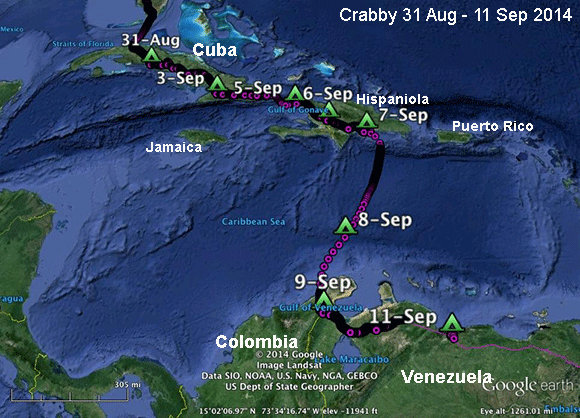 |
Across the CaribbeanCrabby stopped migrating about 1PM on the 31st to do some fishing. After that, she pretty much was all migration all the way to Venezuela. (We can't always tell when birds stop to fish, but track on the 31st was pretty obvious.) Crabby left the D.R. at about 10 AM on 8 Sept. 25 hours later, she made landfall in Venezuela, after a crossing of very close to 500 miles (800 km). She averaged a very average (for Ospreys out over the water) 24 mph. She pushed on to Lake Valencia in northern Venezuela, arriving there on the 11th. She spent 11 days there, and I suspected this might be her winter home. We had one of our tagged birds winter there last year, and it's a rather famous spot for migrating Ospreys, as David Gessner reported in Soaring with Fidel. Wrong again... |
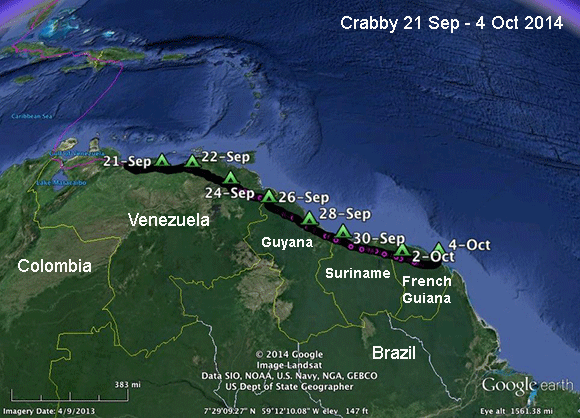 |
Across four countriesThis is a bird on a mission. I've seen this in lots of adults on their first trip south with a transmitter. They get to South America and then make a bee-line for their winter spot. Crabby flew pretty much non-stop for 14 days before getting to the coast of French Guiana. |
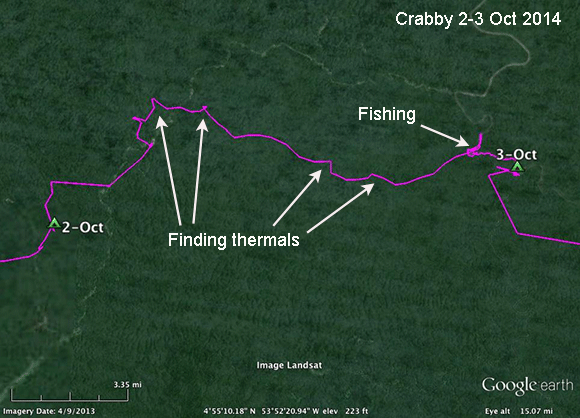 |
Time for some fishingCrabby's roost was on the 3rd of October was only about 15 miles east of her roost on the 2nd. With almost minute-by-minute locations from the cell-tower transmitters, we can really see what the birds are doing as they move across the landscape--in this case, the rainforests of French Guiana. All the zigging and zagging is what we see when the birds are using thermals. They find some rising air, get a free lift and then drift off to the next thermal. This is pretty much effortless migration. In the right side of the map, we can see where Crabby spent some time fishing. We'll look more closely at this in the next map. |
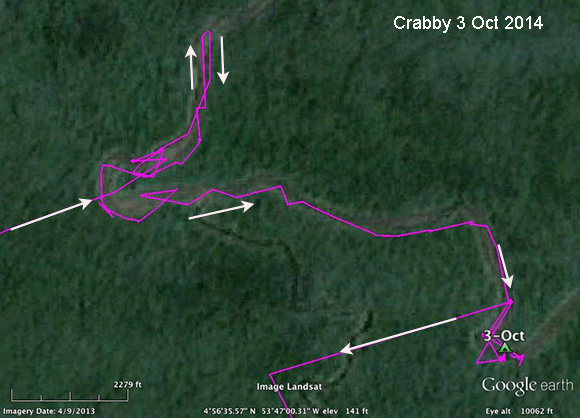 |
A day in the lifeAt 10:06 AM, Crabby came upon the Mana River. She clearly switched from migration to fishing mode. She followed the river downstream for 3/4 of a mile and then turned around and worked upstream. She stopped at and hovered over a spot on the river at least 15 times. At 2:30 there's a 45 minute gap where we have no data and she only moved a couple hundred yards. Maybe during this period she ate a fish. At about 5:30 she stopped moving and settled in for the evening. The next morning our data show her moving at 7:40. 50 minutes later she was back on the move in migration mode again, presumably with some fish in the tank. |
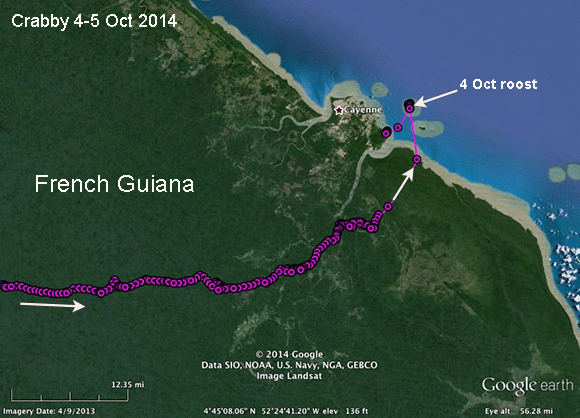 |
Winter homecoming?This looks to me like she's found her winter spot. Since Sept 21st, Crabby has been moving steadfastly southeast. As she got close to the coast of French Guiana, she made a turn to the north, found the coast and flew out to a small island off the mouth of the Mahury River. She spent the night there and then flew back to the coast. No word since the 5th, which does suggest that she moved on--and therefore out of range of cell towers. So maybe on the afternoon of the 4th she could see the coast and headed that way to do some open water fishing before continuing on her migration. But that move up to the island looks suspciously like she's been here before. Time--and the cell towers--will tell. |
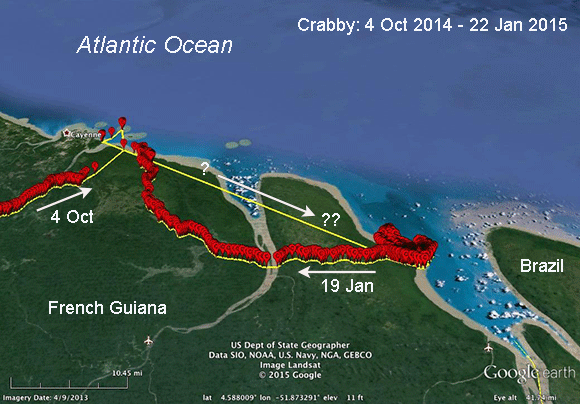 |
Winter homecoming it was!It's unusual to get a surprise in the middle of the winter. At least it was when we had only satellite transmitters on our Ospreys. Now that some of our birds carry cell-tower transmitters, we occasionally have birds pop up after long silences when they wander into an area with celll tower coverage. After 3 months with no signals, I assumed she was dead or had just moved to a spot without cell coverage (there's much more down in South America than one would expect). In either case, we probably would have to wait until spring when she either showed up again somewhere along her migration route, or just never reappeared, which would have meant something had happened to her. So it was a nice surprise to get an email with data from a transmitter number I didn't recognize. (Each message from a cell-tower bird has the ID of the bird.) It had been so long since I'd heard from her that I had to look up the number to see which bird had come back on line. We're missing some data. We don't have any locations from Oct 6th through Dec 20th, so we don't know when she moved down, but from at least the 20th of December to th 19th of January, she was along the coast 50 mi. (80 km) southeast of Cayenne and 10 miles west of Brazil's northernmost state of Amapa. She headed back up to Cayenne on 19 Jan. |
 |
WinterFrench Guinan ornithologist Olivier Claessens provides the following descriptions of where Crabby spent her winter: The area where Crabby is settling now [late January] is totally covered with old mangrove and swampy forest. This is a very remote area, accessible only by boat. It is part of the vast “Marais de Kaw-Roura Nature Reserve” (which harbors large black caimans, the biggest known colony of Agami Herons and many other rare bird species). She headed back up to Cayenne on 19 Jan and spent the rest of the winter in the Marais de Kaw reserve. |
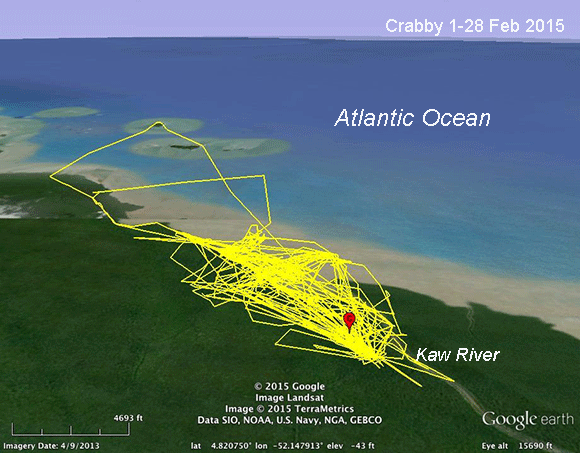 |
February on the Kaw RiverCrabby spent her last two months in French Guiana in the Marais de Kaw-Roura Nature Reserve. This map shows her tracks for the month of February. She spent hours perched out in mangrove trees off the shoreline. |
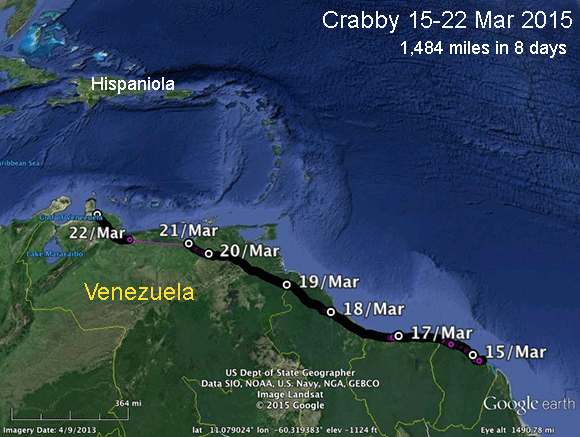 |
Heading home - 15-22 Mar 2015Crabby took off on the 15th of March on a tour of South American capitals. She flew just south of Cayenne, through the outskirts of Paramaibo, and made it past Georgetown without imbibing in the local cool aid! She has roughly 3,000 miles (5,000 km) to go. I expect her back on the Chesapeake sometime in the second week of April. |
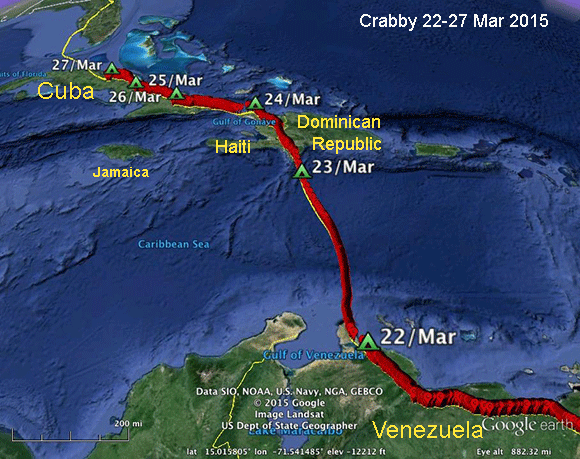 |
Safely across the CaribbeanCrabby crossed the Caribbean on the 22nd and moved straight on to Cuba. She stopped on the 27th for a four-day fishing session. As usual, the crossing was uneventful in the typically benign spring weather. No hurricanes to worry about in March and April. |
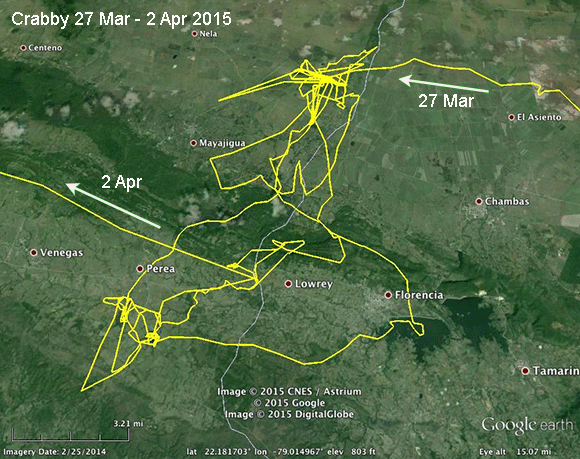 |
Four-day fishing stop in CubaCrabby spent four days refueling in western Cuba. She restarted her migration at 10 am on 2 April. |
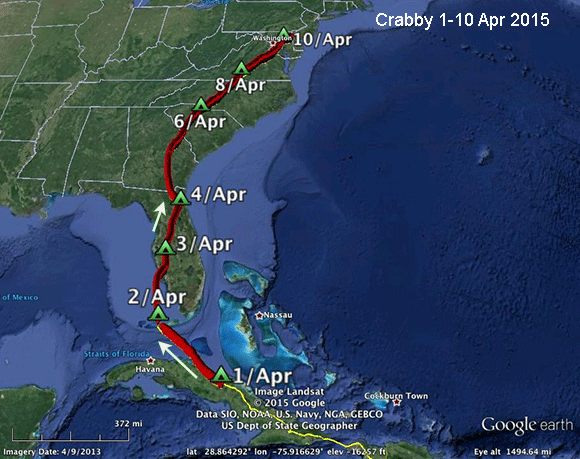 |
The last leg of a long tripCrabby went a bit farther west than necessary leaving Cuba and wound up going over a bit of the eastern Gulf of Mexico. The trip north was uneventful. She did stop on the Dan River, just upstream from where it feeds into Kerr Lake around the NC/VA border. This is a pretty frequently used stopover for north- and south-bound Ospreys. She spent all of the 9th there and then took off for the last day's trip at 10:20 am. Eight hours later, she was home on Kent Island. |
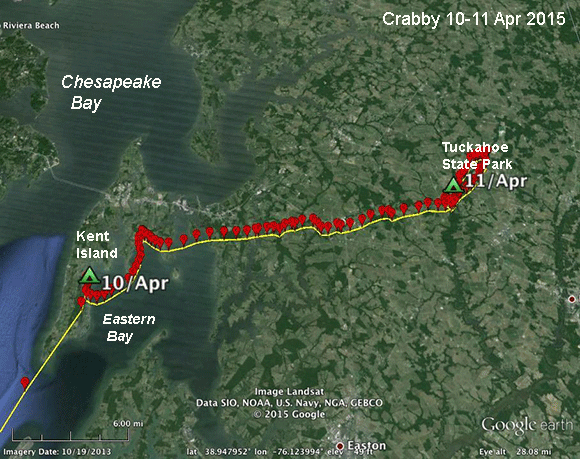 |
Back in the 'hoodCrabby arrived back on Kent Island at 6:20 pm on the 10th and went straight to a spot where she spent a lot of time last year. It looks like there may be a nest pole here. But she didn't stay long before popping over to Tuckahoe State Park for some fishing. She spent a fair bit of time here last year as well. |